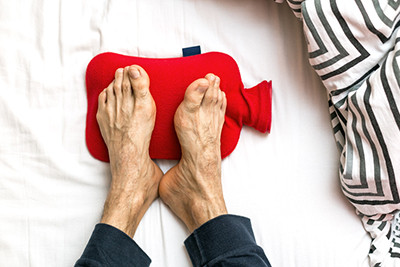On call: Causes of cold feet

Q. My feet are always cold, especially when I go to bed. Could I have a problem with my circulation?
A. Many people frequently have cold feet, as well as cold hands. Some research suggests it may be an inherited trait. When the body’s core temperature drops, the small blood vessels in our hands and feet constrict. This shunts blood away from our extremities to be keep our internal organs warm. People who have less body fat (and therefore less insulation) may be more likely to be bothered by it.
In Raynaud's syndrome, the small blood vessels overcompensate for cold temperatures. This may make the feet feel cold and appear blue and then white. In response to warm temperatures, the feet then turn red.
The main medical problems that cause cold feet are decreased circulation in the extremities and nerve damage, known as neuropathy. One cause of decreased circulation is atherosclerosis, where arteries are narrowed by fatty deposits and impede blood flow in the limbs. As a result, your feet may appear blue or purple when you are sitting, and pale or white when you are lying down. You may feel pain in your calves when you walk. Your doctor can usually detect this condition (peripheral artery disease) by checking the pulses in your feet and legs.
Nerve damage also can cause cold feet. In this case, the person senses a cold sensation because the nerves that detect temperature are not working correctly. The feet do not feel cold to the touch, although the person may feel numbness or a pins-and-needles sensation.
— William Kormos, M.D.
Former Editor in Chief, Harvard Men's Health Watch
Image: Bymandesigns/Getty Images
Disclaimer:
As a service to our readers, Harvard Health Publishing provides access to our library of archived content. Please note the date of last review or update on all articles.
No content on this site, regardless of date, should ever be used as a substitute for direct medical advice from your doctor or other qualified clinician.
















